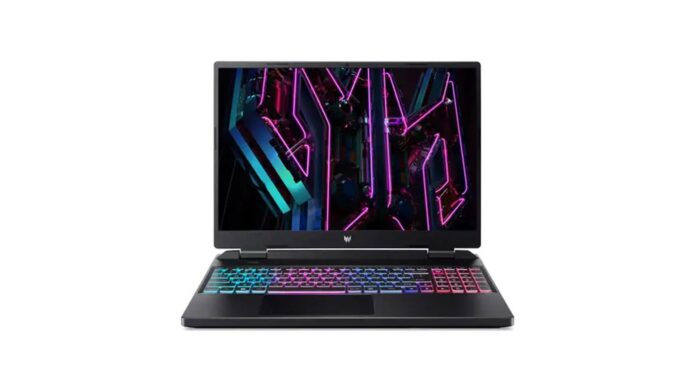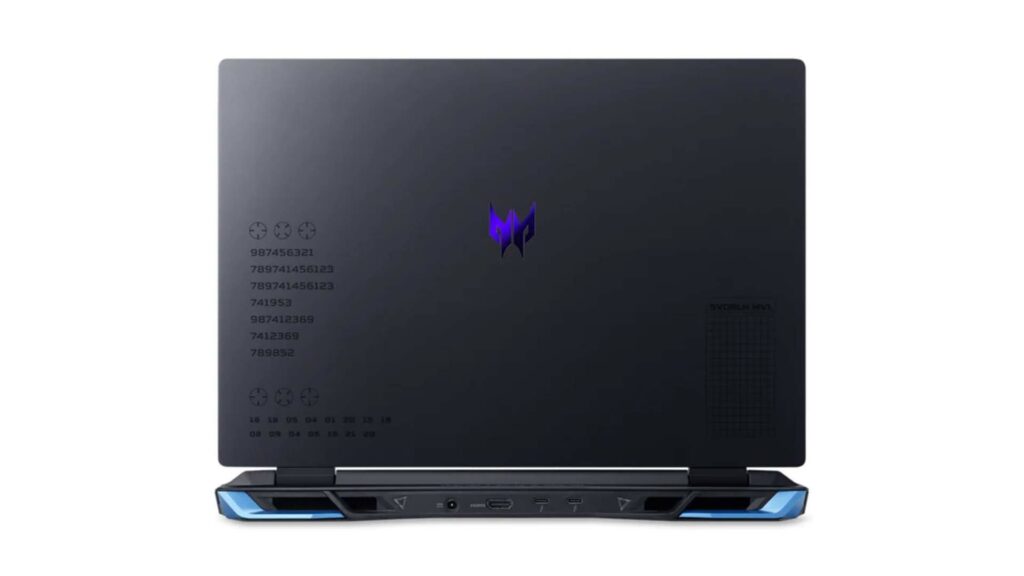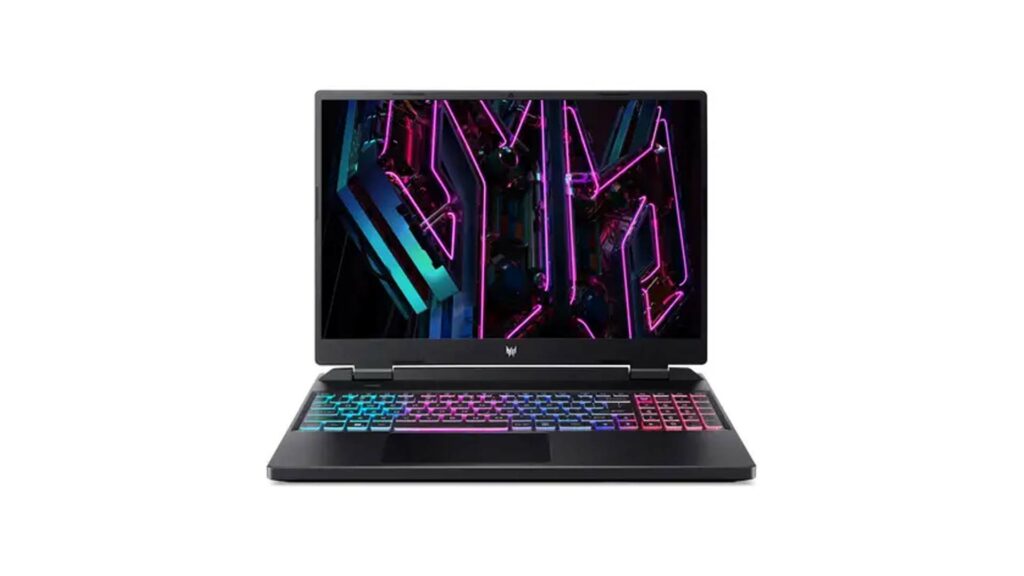Acer’s Nitro and Predator Helios lines are popular choices for budget-conscious gamers seeking solid performance. The Predator Helios Neo series, positioned between these two lines, prioritizes essential features like a full-wattage GPU and a bright, fast display over luxuries such as an all-metal design or per-key RGB lighting.
The Predator Helios Neo 16 shares many similarities with the entry-level Nitro 16, both featuring nearly identical enclosures, with the former sporting an aluminum top cover. Priced at $1,200, both laptops are powered by RTX 4050 GPUs, but the Predator Helios Neo 16 edges ahead in performance, especially in 3D frame rates. Moreover, it becomes an attractive option during sales, recently offered at Best Buy with a substantial $350 discount, bringing the price down to a very reasonable $850.
Acer Predator Helios Neo 16 PHN16-71 Review: Pros and Cons
Pros:
- Impressive 3D performance for budget gaming laptops
- The solid plastic keyboard deck
- Durable aluminum top cover
- Spacious and vibrant 16-inch, 16:10 display
- Clear, 1080p webcam
- Abundance of ports, including Thunderbolt 4
Cons:
- Bulky and heavy build
- The design heavily resembles Acer’s entry-level Nitro 16
- Subpar audio output
- Limited battery life
Acer Predator Helios Neo 16 PHN16-71: Specs and Pricing
- Price: $1,200
- Display: 16-inch 1,920×1,200 165Hz LCD
- CPU: Intel Core i5-13500HX
- Memory: 16GB 4800MHz DDR5
- Graphics: Nvidia GeForce RTX 4050 @ 140 watts
- Storage: 512GB SSD
- Ports: USB-C Thunderbolt 4 (x2), USB-A 3.2 Gen 2 (x2), USB-A 3.2 Gen 1, HDMI, Ethernet, combo audio jack, microSD card reader
- Networking: Killer Wi-Fi 6 AX 1650i and Bluetooth 5.2
- Operating system: Windows 11 Home
The reviewed unit (model PHN16-71) of the Predator Helios Neo 16 line features an Intel Core i5-13500HX CPU, 16GB RAM, Nvidia GeForce RTX 4050 graphics, and a 512GB SSD. While its full price might be steep, it’s often discounted at Best Buy. Higher-end configurations offer up to a 14th-gen Core i9 CPU and RTX 4060 graphics. Most models, like our test unit, boast a 16-inch, 16:10 IPS display with a 1,920×1,200-pixel resolution and 165Hz refresh rate, with at least one variant sporting a 2,560×1,600-pixel, 165Hz display.
The Acer Predator Helios Neo 16 starts at $1,200 (£1,700 in the UK and AU$2,089 in Australia).
Acer Predator Helios Neo 16 PHN16-71: Enhanced RTX 4050 Performance
In the realm of budget gaming laptops, a 16-inch, 165Hz display driven by RTX 4050 graphics is not uncommon, but the Predator Helios Neo 16 stands out with its exceptional performance. Notably, its display surpasses typical budget gaming laptop standards with its brightness and dynamic refresh rate, capable of reaching 165Hz during gaming or video playback and scaling back to 83Hz to conserve battery life during idle periods. Crucially, the RTX 4050 GPU operates at its full wattage, set at 140 watts—115W directly from the GPU and an additional 25 watts borrowed from the CPU through Nvidia’s Dynamic Boost, presenting the highest Total Graphics Power (TGP) achievable with an RTX 4050.
Compared to other budget gaming laptops, such as the HP Victus 16, Lenovo 82XT LOQ 15APH8, and MSI Cyborg 15 A13VE, which feature lower-wattage RTX 4050 GPUs, the Predator Helios Neo 16 demonstrates superior performance across various benchmarks. It notably outperforms competitors in 3D gaming tests, 3DMark benchmarks, and Cinebench tests for 2D graphics performance.
While its application performance fluctuates, with a strong showing in Geekbench 6 but middling scores in comparison to other budget gaming laptops, Acer’s strategic decision to pair a midrange 13th-gen Core i5 CPU with a maxed-out RTX 4050 GPU proves advantageous for gamers prioritizing 3D performance.
A standout feature of the Predator Helios Neo 16 is its impressive display quality. Achieving a peak brightness of 442 nits and covering 100% of the sRGB gamut, it surpasses its competitors in brightness and color accuracy. In contrast, rival models like the MSI Cyborg 15, HP Victus 16, and Lenovo LOQ 82XT fall short in brightness and color gamut coverage.
However, the trade-off for such a vibrant display, coupled with a 55-watt HX-series CPU and full-wattage RTX 4050, is shorter battery life, lasting just 6.5 hours in online streaming battery-drain tests. Nevertheless, for users prioritizing display quality and performance over extended battery life, the Predator Helios Neo 16 proves to be a compelling choice, offering vivid colors, enhanced detail visibility, and superior frame rates.
Unveiling the Nitro-Inspired Predator Helios Neo 16
The Predator Helios Neo 16 presents a blend of a plastic keyboard deck and aluminum top cover, setting it apart from most budget gaming laptops predominantly made of plastic. Unlike the all-aluminum enclosure of Acer’s Predator Helios (non-Neo) line, the Neo variant leans towards plastic construction. In essence, it shares similarities with the Nitro 16, featuring identical keyboard decks and keyboards with subtle alterations to the venting pattern above the keys. The WASD keys, four arrow keys, and the hotkey for Acer’s PredatorSense app sport blue translucent edges instead of bold white, contributing to a less overtly gamer-centric appearance.
Despite its plastic composition, the keyboard deck maintains sturdiness, providing a solid platform for intensive gaming sessions. However, its bulk and weight pose limitations, with a relatively thick profile and a weight of 5.7 pounds, making it less portable compared to sleeker alternatives. Yet, compared to its counterpart, the Nitro 16, the Predator Helios Neo 16 benefits from a marginally lighter power brick, enhancing its overall mobility.
The keyboard’s four-level, four-zone RGB lighting offers customization options beyond typical budget gaming laptops, albeit lacking the sophistication of per-key RGB lighting found in the non-Neo Helios line. While offering snappy feedback during gaming, the keys lack the deep travel characteristic of higher-end models. Additionally, the inclusion of the PredatorSense button, akin to NitroSense, with no functional difference between the two apps, highlights a shared element between the Nitro and Predator series.
In terms of display, the Predator Helios Neo 16 mirrors the Nitro 16, boasting a 16-inch panel with a 1,920×1,200-pixel resolution and a 16:10 aspect ratio. Notably, both displays excel in brightness and vibrancy, enhancing the visual experience beyond typical budget gaming standards. The 16:10 aspect ratio contributes to a more expansive screen, facilitating multitasking outside of gaming scenarios.
While both laptops suffer from flat sound output from downward-firing stereo speakers, the Predator Helios Neo 16 gains an advantage with its sharper, 1080p webcam compared to the Nitro 16’s 720p counterpart. However, the absence of biometric features like an IR sensor or fingerprint reader compromises convenient login options.
In terms of connectivity, the Predator Helios Neo 16 offers ample ports distributed across its sides and back edge, with the power connector conveniently located at the rear for improved cable management.
Priced at $1,200 for the RTX 4050 configurations tested, the Predator Helios Neo 16 edges ahead of the Nitro 16 with its enhanced performance, aluminum top cover, and higher-resolution webcam. Moreover, its occasional discounts, dropping to as low as $850 at Best Buy, make it a compelling choice for budget-conscious gamers. However, if the Predator Helios Neo 16 proves elusive on sale, the Nitro 16, priced at $900 during promotions on Newegg, offers a worthy alternative. Both models present excellent value propositions when available for less than $1,000.



